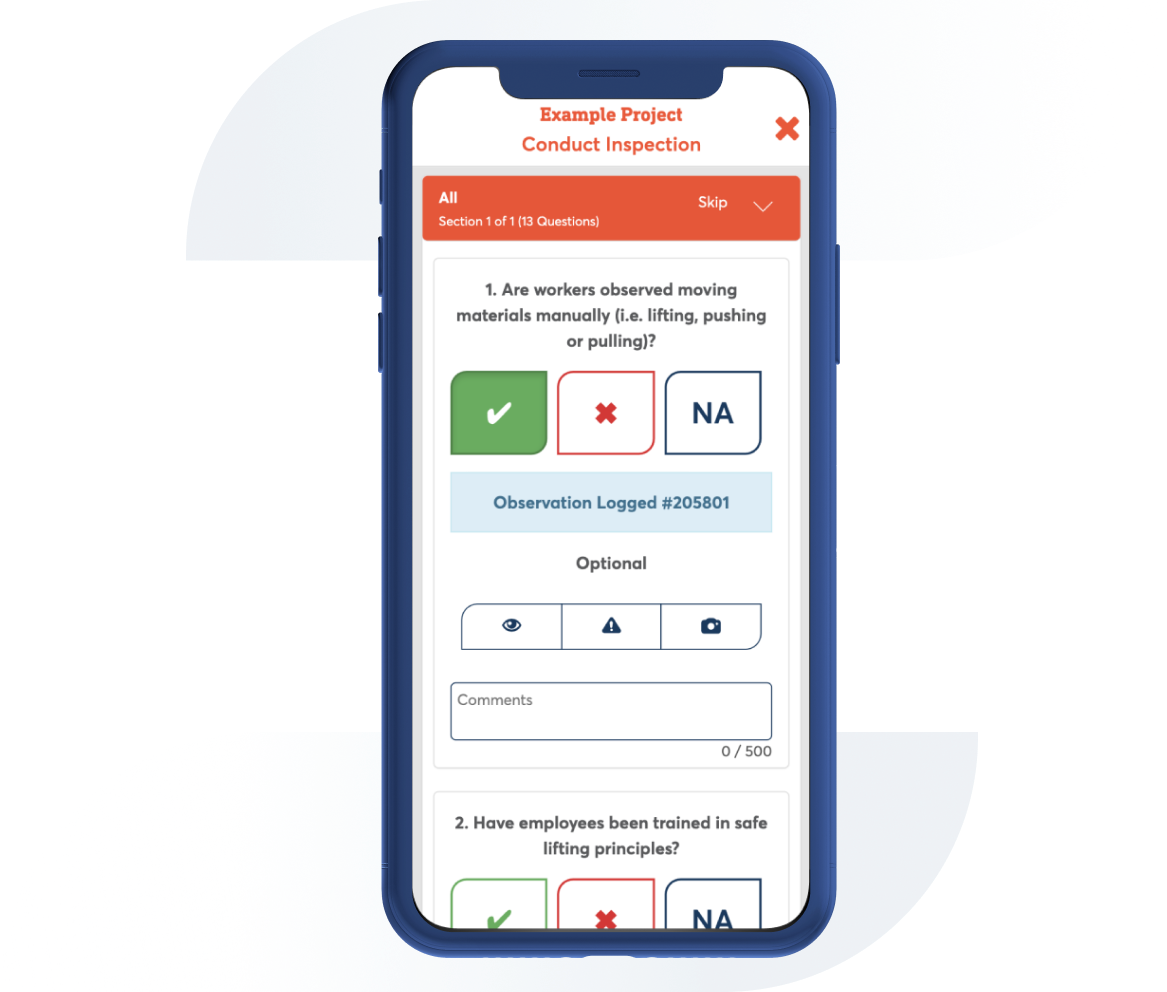Tree Care Project Safety Audit
Contributor: Safesite HQ Jurisdiction: OSHA
Use this inspection form to conduct a Tree Care Project Safety Audit.

Template Preview
1. Auditor Name
2. Date
3. Location
4. Arrival Time
5. Does the crew appear to be fit for duty?
Actions
6. Does the crew appear to be maintaining hydration?
Actions
1. Traffic Signs
Actions
2. Traffic Cones
Actions
3. Drop Zone Cones
Actions
4. Wheel Chocks
Actions
5. Spill Kits
Actions
6. Traffic Control
Actions
7. Comments
1. Hard Hat
Actions
2. Safety Glasses
Actions
3. High Visibility Vest
Actions
4. Fall Arrest Harness
Actions
5. Ear Plugs
Actions
6. Gloves
Actions
7. Comments
1. Fire extinguisher
Actions
2. First Aid Kit
Actions
3. Fire Tools (1 per employee)
Actions
4. Water Backpack
Actions
5. Water Trailer
Actions
6. Comments
1. PTP Completed and Communicated
Actions
2. Tree Assessment
Actions
3. MAD Listed
Actions
4. Emergency Plan Safety Binder
Actions
5. Aerial Rescue
Actions
6. Safety Binder
Actions
7. SDS Sheets
Actions
8. Comments
1. Gear Inspected Prior to Use
Actions
2. Back-up Climber
Actions
3. Back-up Climbing Gear in Place
Actions
4. Good Communication (3-Way)
Actions
5. Good Tie-in Point
Actions
6. Tree Inspection Completed
Actions
7. Comments
1. Maintained saw (sharp)
Actions
2. Two Hands on Saw
Actions
3. Insulator on Pruner
Actions
4. Hand Saw in Place
Actions
5. Fuel Station Used
Actions
6. Chain Saws in Good Condition
Actions
7. Comments
1. Truck Inspection Completed
Actions
2. Good Set-up
Actions
3. Rescue Plan in Place
Actions
4. Good Communication (3-Way)
Actions
5. Qualified Operator
Actions
6. Bucket Harness being used
Actions
7. Comments
1. Maintained, Blades (sharp)
Actions
2. Safety Functions Operational
Actions
3. Employees Side Feeding Material
Actions
4. Break-Away Vest or No Loose clothing
Actions
5. Chains and Trailer Plug in Good Condition
Actions
6. Cone Zone leaves room for safe chipping
Actions
7. Comments
1. Could the tree contact the lines?
Actions
2. Working on a slope?
Actions
3. Can the tree be climbed?
Actions
4. Comments
1. Chainsaw Operated Properly
Actions
2. Using Good Knots, Bends, Hitches
Actions
3. Good Tie-in Point/Bucket Harness used
Actions
4. Good cuts being made
Actions
5. Good communication skills
Actions
6. Comments
1. Chainsaw Operated Properly
Actions
2. Chaps Being Worn
Actions
3. Proper Cuts Being Made
Actions
4. Proper Rope for Rigging
Actions
5. Good communication skills
Actions
6. Comments
1. Has complete control at all times
Actions
2. Proper Rest given to Each Crew member
Actions
3. PTP and Emergency Plan Communicated to All On-Site
Actions
4. Comments
1. Proper Equipment Being Used
Actions
2. Operator Qualified
Actions
3. Operator Communicating with Crew
Actions
4. Safe and Controlled Operations
Actions
5. Comments
1. Contractors must conduct ongoing training of environmental law and procedures.
Actions
2. On federal, state, local, and tribal land managers should be notified of pending work as far in advance as possible.
Actions
3. Roads, erosion control measures, fences, and structures damaged as a result of vegetation management operations must be repaired and reported to the work group supervisor and the PGE representative. Gates should be left as they are found.
Actions
4. Vehicles and equipment must use pavement, existing roads, and previously disturbed areas to the extent practicable.
Actions
5. Motorized equipment must comply with Air Resources Board permitting requirements.
Actions
6. Vehicle idling, noise, and odor must be minimized to the extent practicable when working near residences, public buildings, or commercial buildings. Diesel-fueled work vehicles must not stand idling for more than five minutes at any location, unless necessary for work purposes.
Actions
7. Contractors must have a means of communication on the job site at all times.
Actions
8. Vehicles and heavy equipment must be refueled at least 100’ away from riparian areas. Handheld tools must be refueled outside of riparian areas. The fueling operator must stay with the fueling operation at all times. Do not top off tanks.
Actions
9. Petroleum and herbicide spill containment and cleanup materials must be available at the job site. Spills must be immediately cleaned up and contaminated materials disposed of properly.
Actions
10. Immediately after vegetation management activities, if the amount of contiguous, bare soil exposed in one location exceeds 0.1 acres, erosion control measures must be implemented.
Actions
11. Vehicle use within riparian areas is limited to existing roads and dry crossings, and they must be checked and maintained daily to prevent leaks of materials, that, if introduced to water, could be harmful to aquatic life.
Actions
12. Cleared or pruned vegetation and woody debris, including chips, must be disposed of in a manner to ensure that it does not enter surface water or a watercourse. All cleared vegetation and woody debris, including chips, must be removed from surface water or watercourses, and placed or secured where it cannot enter the watercourse.
Actions
13. Trees should be felled away from riparian areas. Chippers should blow debris away from riparian areas. Debris should be dropped from heights away from riparian areas.
Actions
14. Comments

Can't find what you are looking for?
